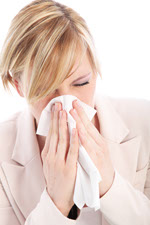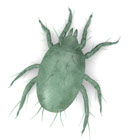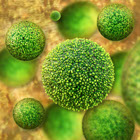Allergies Sinusitis Balloon Sinus Surgery
Allergies

Millions of Americans suffer from nasal allergies, commonly known as hay fever. Often fragrant flowers are blamed for these symptoms, yet they are rarely the cause; their pollens are too heavy to be airborne. The specialists at New England ENT can help determine the substances causing your discomfort and develop a management plan that will help make life more enjoyable. We offer highly sensitive allergy testing and immunotherapy options such as subcutaneous immunotherapy (allergy shots) or sublingual immunotherapy (allergy drops) for patients of all ages.
Why does the body develop allergies?
Allergy symptoms appear when the immune system reacts to an allergic substance as though it were an unwelcome invader. The immune system produces special antibodies capable of recognizing the same allergic substance if it enters the body at a later time. When an allergen reenters the body, the immune system rapidly recognizes it, causing a series of reactions. These reactions often involve blood vessel dilation, and production of many inflammatory substances, including histamine. Histamine produces common allergy symptoms such as itchy, watery eyes, nasal and sinus congestion, headaches, sneezing, scratchy throat, hives, shortness of breath, etc.
What are common allergens?
Many common substances can be allergens. Pollens, food, mold, dust, feathers, animal dander, chemicals, drugs such as penicillin, and environmental pollutants commonly cause many to suffer allergic reactions.
- Pollens: One of the most significant causes of allergic rhinitis in the United States is ragweed. It begins pollinating in late August in most of the U.S. and continues until the first frost. Late springtime pollens come from grasses like timothy, orchard, red top, sweet vernal, Bermuda, Johnson, and some bluegrasses. Early, spring-time allergies are most often caused by pollens of trees such as elm, maple, birch, poplar, beech, ash, oak, walnut, sycamore, cypress, hickory, pecan, cottonwood and alder. Flowering plants rarely cause allergy symptoms.


- Household allergens: Certain allergens are present all year long (known as perennial allergens). These include house dust, pet dander, and some foods and chemicals. Symptoms caused by these allergens often worsen in the winter when the house is closed up, due to poor ventilation.
- Mold: Mold spores can also cause allergy problems. Molds are present all year long and grow both outdoors and indoors. Dead leaves and farm areas are common sources for outdoor molds. Indoor plants, old books, bathrooms, and damp areas are common sources of indoor mold growth. Mold is also common in foods.
How can allergies be managed?
Allergies are rarely life threatening, but can have a significant negative impact on one’s quality of life. They often cause lost time from work and school, decreased work efficiency and poor school performance. In fact, recent studies have shown that allergies can have as much of an impact on one’s life as chronic conditions such as diabetes and hypertension. Considering the millions of dollars spent on anti-allergy medications and the cost of lost work time, allergies cannot be considered a minor problem. For some allergy sufferers, symptoms may be seasonal, but for others they produce year-round discomfort. Allergies are also often associated with conditions such as chronic and recurrent sinusitis, nasal polyps, asthma, chronic cough, hoarseness, and even balance problems (such as Meniere’s disease).
Symptom control is most successful when multiple approaches are used simultaneously to manage the allergy. They may include minimizing exposure to allergens, desensitization with allergy shots or drops, and medications. If used properly, medications, including antihistamines, nasal decongestant sprays, steroid sprays, saline sprays, and cortisone-type preparations, can be helpful. Even over-the-counter drugs can be beneficial, but some may cause drowsiness.

When should a doctor be consulted?
The most appropriate person to evaluate allergy problems affecting the ears, nose and throat is an otolaryngologist (ear, nose, and throat specialist). The providers at New England ENT will gather a detailed history and perform a thorough examination of the ears, nose and throat. Examination may include the use of a fiber-optic telescope to evaluate the nasal passages and sinuses to also determine if infection or structural abnormality (deviated septum, polyps) is contributing to the symptoms. Patients may be recommended to undergo allergy testing to determine the specific allergen(s) that is causing symptoms. This will help counsel patients on allergy management through environmental control and optimizing medical therapy. In some cases subcutaneous immunotherapy (allergy shots) or sublingual immunotherapy (allergy drops) may be recommended. Immunotherapy can treat allergies by desensitizing a patient to allergens over time, and in many cases with the goal that they be cured of their allergies.
Tips for reducing the exposure to common allergens
- Wear a pollen mask when mowing grass or cleaning house (most drugstores sell them).
- Change your air filters regularly in heating and air conditioning systems and vacuum cleaners and/or install an air purifier. Consider a HEPA filter in your bedroom or other rooms where you spend a lot of time.
- Keep windows and doors closed during heavy pollen seasons.
- Wipe down indoor-outdoor animals as they return inside to remove pollen on their fur.
- Use daily saline nasal rinses to cleanse your nose and sinuses of the offending allergens.
- Rid your home of sources of mildew.
- Try not to allow dander-producing animals (i.e., cats, dogs, etc.) into your home and bedroom. However, if you have a pet, ask your physician for suggestions to allow you to enjoy your pet while also enjoying a life free of allergies.
- Change feather pillows, woolen blankets, and woolen clothing to cotton or synthetic materials.
- Enclose mattress, box springs, and pillows in a plastic barrier.
- Use over-the-counter antihistamines and decongestants as needed and as tolerated. However, you will likely find the best allergy symptom control with topical nasal sprays and eye drops that can be prescribed by your ENT.
- Sleep with the head of the bed tilted upward which can help relieve nasal congestion.
- Discuss hay fever and allergy symptoms with a physician when experiencing an allergic reaction.
What are food allergies?
Dust, mites, pet dander, and ragweed are not the only allergic threats in our environment. Food allergies and sensitivities may cause a wide range of adverse reactions to the skin, respiratory system, stomach, and other physiological functions of the body. Both children and adults are susceptible to food allergies. Children often have more skin reactions, such as eczema, to foods than do adults. However, children also often outgrow food sensitivities over time. While food allergies may fade over time, inhalant (such as dust and ragweed) allergies may begin to appear later as one gets older.

There are 2 types of food allergies:
- Fixed (immediate) food allergies: Approximately 5-15% of food allergies are of the fixed variety. This may be very apparent, such as the child whose lips swell and throat itches immediately in response to eating peanuts. The cause for this type of food allergy is similar to that of inhalant allergies, so the diagnosis is more easily reached. Blood testing (i.e., RAST test) is typically used to verify fixed food allergies.
- Cyclic (delayed) food allergies: These allergies are far more common but less understood. Delayed food allergy symptoms can take up to 3 days to appear. This type of reaction is associated with the body’s IgG antibodies. Unlike fixed food allergies, this allergic response is cyclical in nature. As an example, a child may be IgG sensitive to milk. Consequently, symptoms might appear if the child increases the intake and/or frequency of milk consumption.
Diagnosing and treating the cyclic food allergy
If your child is experiencing allergic reactions to food of unknown origin, you should ask, “Are there any foods that my child craves or any food that I avoid offering?” These foods may be the ones that are causing difficulties for the young patient.
Your physician may also suggest the Elimination and Challenge Diet. This dietary test consists of the following steps:
- Keep a detailed food diary, tracking what was eaten (including ingredients), when it was eaten, medications taken, and any symptoms that developed. Be honest! Some well-meaning parents or caregivers often create a food diary that looks healthier than it really is. Your child can receive the best diagnosis if the diet records are accurate, timed precisely, and truthful. This diary can be evaluated by the doctor to identify which food items may be culprits.
- Conduct an elimination and challenge diet at home based upon your physician’s assessment of your child’s diet diary. It is best if you carefully maintain a new diet diary for your child during this period. During this diet, your child must abstain from one, and only one, of the possible food culprits at a time for a period of four days. This can be difficult to carry out if the food is very common, such eggs or cereal, so you need to pay strict attention to your child’s diet during the elimination phase. Any cheating will invalidate the results. On the fifth day, you will be asked to feed your child the suspected culprit food item. This is the challenge! Provide your child an average-sized portion of the food in question to be eaten in five minutes. In one hour the child should eat another half portion if no symptoms have developed. Any symptoms that develop are then timed and recorded. With a true cyclic food allergy, you would expect a significant worsening of the symptoms described in the original diet diary, although the challenge symptoms may vary as well.
- If the Elimination and Challenge Diet confirms a cyclic food allergy, then you will be asked to abstain from feeding your child this food for a period of three to six months. After this time you can slowly reintroduce the food on a rotary basis; it is not to be eaten more frequently than every four days (once or twice a week).
For minor to moderate discomfort from the testing, you can consider one of the following treatment options:
- Children’s laxative.
- Alka Seltzer Gold.
- Buffered Vitamin C (1 gram).
* Fixed food allergies should never be deliberately challenged unless under the direct supervision of a physician.
